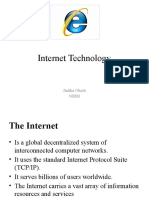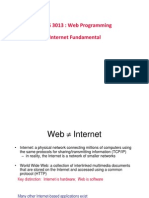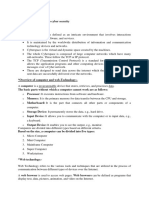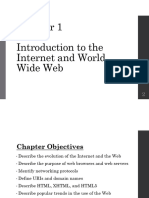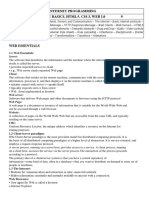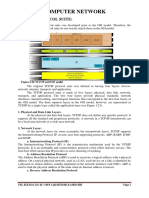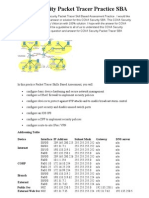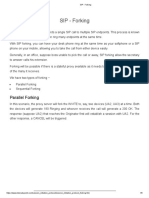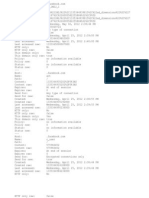Web Application
A web-application is an application program that is usually stored on a remote server, and users
can access it through the use of Software known as web-browser.
Web Page
A web page is a document written in hypertext (also known as HTML) that we can see online,
using a web browser. Most web pages include text, photos or videos, and links to other web pages.
A group of many web pages managed by one person or company is a website.
Website
A website (also written as a web site) is a collection of web pages and related content that is
identified by a common domain name and published on at least one web server.
Web browser
A software application used to access information on the World Wide Web is called a Web
Browser. When a user requests some information, the web browser fetches the data from a web
server and then displays the webpage on the user's screen.
URL
A URL (Uniform Resource Locator) is a unique identifier used to locate a resource on the Internet.
It is also referred to as a web address. A typical URL could have the form
http://www.example.com/index.html, which indicates a protocol (https), a hostname
(www.example.com), and a file name (index. html).
WWW
WWW (World Wide Web) is a huge collection of pages of information linked to each other around
one globe. Every page is a combination of text, picture, audio, video, animation and hyperlink
HTTP
HTTP (Hypertext Transfer Protocol) is the set of rules for transferring files such as text, images,
sound, video and other multimedia files over the web. As soon as a user opens their web browser,
they are indirectly using HTTP. HTTP is an application protocol that runs on top of the TCP/IP
suite of protocols, which forms the foundation of the internet.
Web Architecture
WWW follows 2-tier architecture. It is a combination of web servers and web clients. Web servers
produce to deliver information and web client retrieve to display information.
HTML
HTML stands for Hyper Text Markup Language. HTML is the standard markup language for
creating Web pages. HTML describes the structure of a Web page. HTML consists of a series of
elements. HTML elements tell the browser how to display the content.
�It is not a programming language. It is a markup language. Markup language is a set of tags.
HTML file is saved with .html extension.
Structure of HTML
<html>
<head> … </head>
<body> … </body>
</html>
Cookies
Cookies are small pieces of text sent to user’s browser by a website the user visit. They help that
website remember information about user’s visit, which can both make it easier to visit the site
again and make the site more useful to user.
Types of Protocols
Transmission Control Protocol (TCP): TCP is a popular communication protocol which
is used for communicating over a network. It divides any message into series of packets
that are sent from source to destination and there it gets reassembled at the destination.
Internet Protocol (IP): The Internet Protocol (IP) is a protocol, or set of rules, for routing
and addressing packets of data so that they can travel across networks and arrive at the
correct destination. TCP/IP is the most popular protocol connecting the networks.
User Datagram Protocol (UDP): UDP is a substitute communication protocol to
Transmission Control Protocol implemented primarily used across the Internet for
especially time-sensitive transmissions. Video Conferencing apps like Skype, Google
meet, Zoom, all use the services of UDP due to the fact that they are real-time applications
and any delay in receiving the data cannot be tolerated.
Simple mail transport Protocol (SMTP): SMTP is designed to send and distribute
outgoing E-Mail.
File Transfer Protocol (FTP): FTP allows users to transfer files from one machine to
another. Types of files may include program files, multimedia files, text files, and
documents, etc.
Hyper Text Transfer Protocol (HTTP): HTTP (Hypertext Transfer Protocol) is the set
of rules for transferring files such as text, images, sound, video and other multimedia files
over the web. As soon as a user opens their web browser, they are indirectly using HTTP.
HTTP is an application protocol that runs on top of the TCP/IP suite of protocols, which
forms the foundation of the internet.
Hyper Text Transfer Protocol Secure (HTTPS): It is a standard protocol to secure the
communication among two computers one using the browser and other fetching data from
web server. So it can be said that https fails hackers from interpretation or modification of
data throughout the transfer of packets.
� Telnet: Telnet (Teletype Network Protocol) is a set of rules designed for connecting one
system with another remotely (old technology, used before internet). The connecting
process here is termed as remote login. The system which requests for connection is the
local computer, and the system which accepts the connection is the remote computer.
Gopher: Gopher is a collection of rules implemented for searching, retrieving as well as
displaying documents from isolated sites (old technology, used before http). Gopher also
works on the client/server principle.








